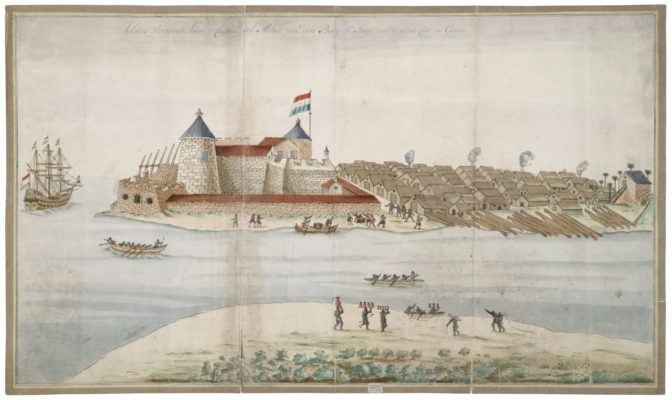Slavenhandel is the slave trade.
The Dutch West India Company was heavily involved in transporting slaves. They had an outpost in Elmina on Africa’s Gold Coast, where they gathered the enslaved people bought or captured in Africa. Ships would sail from Amsterdam with merchandise to buy slaves on the local slave markets in Africa, from where they would bring them to the West Indies or New Netherland. On the way back, the ships brought the proceeds from the colonies, such as sugar, tobacco, and pelts.

Fortress of El Mina in Ghana, 1706. Credits: Nationaal Archief (public domain)
But other Dutch companies were also involved in the slave trade. An example is the Middelburgse Commercie Compagnie, out of Middelburg in Zeeland. The MCC archives were added to UNESCO’s World Heritage register in recognition of their importance for the international study of the slave trade.
It is estimated that about 5% of the people who were transported in the Trans-Atlantic Slave Trade were on Dutch ships. These transactions left records in the Netherlands too, for example in Amsterdam notarial records. For an example, see “negroes for New Netherland,” which features a notarial contract from 1661.
Further study
- Mapping Slavery, showing where slave owners lived in the Netherlands.
- MCC Slave Voyage: The Unity 1761-1763, Zeeuws Archief.
- Into the Triangle Trade, Google Arts & Culture presentation by Zeeuws Archief.
- Dutch Involvement in the Transatlantic Slave Trade and Abolition, Universiteit Leiden.
- Projects relating to the Slave Trade, Shared Mutual Heritage.


The African-American Museum in Washington DC has an overwhelming (I thought) amount of information about all the slave ships running between Africa and the Americas, including the many Dutch ships. One detail that caught my attention for some reason was how significantly worse the survival rate was on French ships compared to other nations’ ships.